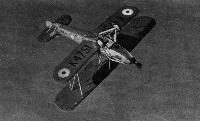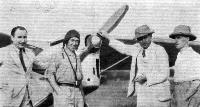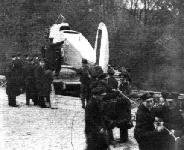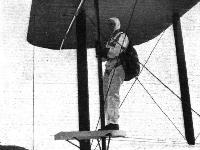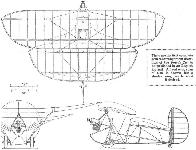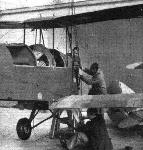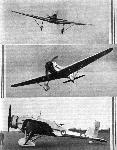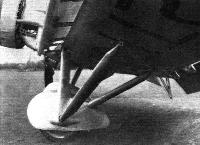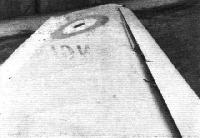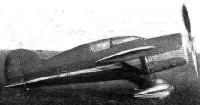Фотографии
-
Регистрационный номер: K4751 YELLOW PERIL: A Hawker "Hart Trainer" (525 h.p. "Kestrel I.B.") painted yellow, in accordance with the new regulations applying to Service trainers, disports itself over Brooklands.
Самолёты на фотографии: Hawker Hart - Великобритания - 1928
-
Регистрационный номер: G-ADAW Genesis: This photograph, taken by a Flight photographer from a standard "Hawk" (Cirrus III), shows the "Hawk Major" (Gipsy Major), the "Falcon" (Gipsy Major) and, at the top, the "Merlin" (Gipsy Six).
Самолёты на фотографии: Miles Falcon M.3 / Hawcon M.6 - Великобритания - 1934Miles Hawk / M.2 - Великобритания - 1932Miles Merlin / M.4 - Великобритания - 1935
-
M.t. G W.. Wilson, deputy general manager of Shell-Mex, receiving the log-books of the "Hawk Major" from Mr. Powis and Mr. Miles at Reading last week.
Самолёты на фотографии: Miles Hawk / M.2 - Великобритания - 1932
-
The front cockpit of the Miles "Hawk Major" has been very fully equipped with instruments for indicating the temperatures of petrol, oil, cylinder heads, etc.
Самолёты на фотографии: Miles Hawk / M.2 - Великобритания - 1932
-
Регистрационный номер: G-ADER One of the first batch of production-model Miles "Falcons," taken last week-end by a Flight photographer over Reading Aerodrome, where the makers' works are situated, and which is the home of the Reading Aero Club. The engine of the "Falcon" is a 130 h.p. "Gipsy Major" and the cabin seats three passengers and a pilot in comfort.
Самолёты на фотографии: Miles Falcon M.3 / Hawcon M.6 - Великобритания - 1934
-
Mr. Brook being congratulated by Flt. Lt. "Tommy" Rose on his arrival at Lympne.
Самолёты на фотографии: Miles Falcon M.3 / Hawcon M.6 - Великобритания - 1934
-
Регистрационный номер: K3183 Ready for test: A Bristol "Bulldog" with Napier "Rapier" engine on the balance of the 24ft. wind tunnel. Control of the exit of the cooling air reduced the cost of cooling to 1 per cent. of the power of the engine.
Самолёты на фотографии: Bristol Bulldog - Великобритания - 1927
-
A 550 h.p. supercharged "Wasp" gives the Boeing 281 a speed of 232.5 m.p.h. The "treadle" type undercarriage is an interesting feature.
Самолёты на фотографии: Boeing P-26 Peashooter - США - 1932
-
AN ELOQUENT ARRAY. A concentration of Fairey "Foxes" and "Fireflies" with Rolls-Royce "Kestrel IIS" engines at Everes Aerodrome, Belgium. The King of the Belgians has flown in one of the "Foxes."
Самолёты на фотографии: Fairey Firefly - Великобритания - 1925Fairey Fox - Великобритания - 1925
-
Регистрационный номер: K4296 "WITH BOOTS ON." Senor de la Cierva testing a C.30 Autogiro seaplane over the Medway at Rochester, where it has been fitted with floats by Short Brothers. The first Autogiro seaplane had an Avro "Avian" fuselage and was persuaded off the water off Hamble in Southampton Water. This happened many years ago, when the present system of rotor-starting had not been evolved.
Самолёты на фотографии: Cierva/Avro C.30A / Rota - Великобритания - 1932
-
SALUTE: The Duke of Gloucester, who is now home in England, made several flights during his world tour. At Balboa, Canal Zone, he broke his homeward journey in order to make a long flight over the Isthmus of Panama in a U.S. Navy Douglas "Dolphin." A detachment of the 33rd United States Infantry is here shown giving the Duke a musical send-off on that occasion
Самолёты на фотографии: Douglas Dolphin / RD / OA-4 - США - 1930
-
Регистрационный номер: G-ACRN THE MODERN TOUCH: An attractive view, taken from beneath Syrinx's fuselage by a Flight photographer, of the re-named Avatar (now Ava, for diplomatic reasons), one of Imperial's two new high-speed Avro charter monoplanes.
Самолёты на фотографии: Avro Anson / Type 652 - Великобритания - 1935Short Scylla / L.17 - Великобритания - 1934
-
Регистрационный номер: G-ADAE UNITED'S FIRST: The new Dragon "Rapide," finished in silver with red struts, for United Airways' London-Blackpool service, which will be opened next month.
Самолёты на фотографии: De Havilland Dragon Rapide / Dominie / D.H.89 - Великобритания - 1934
-
ETHYLISED: The "Dragon Six" which the Ethyl Export Corporation has just taken over for work in Europe and the East. The "Gipsy Six" engines have special aluminium cylinder heads with steel valve seats and Stellited valves, to enable advantage to be taken of the widespread supplies of leaded fuels of high octane value. The cabin is luxurious and the machine is finished in black and yellow. Mr. D. W. Lucke is the pilot.
Самолёты на фотографии: De Havilland Dragon Rapide / Dominie / D.H.89 - Великобритания - 1934
-
Регистрационный номер: G-ABZP Flt Lt Geoffrey Tyson surveys a sea of upturned faces from his inverted Lynx-engined Avro Tutor G-ABZP at Redhill on April 13, 1935.
Самолёты на фотографии: Avro Tutor/Sea Tutor/Prefect / Type 621/646/626 - Великобритания - 1929Goppingen Go.1 Wolf - Германия - 1935
-
GETTING TOGETHER: Capt. J. C. Hargreaves, Mr. L. P. Hirsh, of Airports, Ltd., Mr. E. W. Percival, designer of the 1935 "Gull" seen in the background, and Mr. R. L. Preston, snapped at Heston recently.
Самолёты на фотографии: Percival Gull - Великобритания - 1932
-
BERLIN LOOKS SKYWARD. The annual "People's Flying Day" was celebrated at Tempelhof Airport last Sunday, and this time the open possession of an air force added to the spectacular nature of the event, which was combined with "Air Force Day," the anniversary of Richthofen's death. The formation seen in this photograph is a very non-aggressive one of Klemm monoplanes.
Самолёты на фотографии: Klemm L.25 - L.28 Swallow - Германия - 1927
-
THE TRIAL OF '35: A new Bellanca "Cargo Aircruiser," with a 700 h.p. Wright "Cyclone" engine, which has been delivered to Mackenzie Air Service, Ltd., the Canadian company, for work in connection with silver mining. The company's president, Mr. Leigh Brintnell, is here seen beside the new acquisition, of which he is also the pilot.
Самолёты на фотографии: Bellanca Model P Airbus / 66 Aircruiser - США - 1930
-
AN OUTSIZE IN AMPHIBIANS: Powered with two geared "Cyclones" of 715 h.p., this big Bellanca amphibian carries eighteen passenger at cruising speed of about 170 m.p.h. There is over fifty cubic feet of baggage space in the stub wings. The machine is a development of the Bellanca bomber, described in Flight, of February, 8 this year.
Самолёты на фотографии: Bellanca 77 Bomber - США - 1934
-
Two baby antelopes on arrival at Los Angeles from Wyoming, a distance of 1,500 miles.
Самолёты на фотографии: Fairchild C-61 Forwarder / Model 24 / Argus - США - 1932
-
Loading a young antelope, destined for a zoo, into a Fairchild 24 cabin monoplane
Самолёты на фотографии: Fairchild C-61 Forwarder / Model 24 / Argus - США - 1932
-
A fine impression of fleet-footed pronghorn buck - known in America as antelope - fleeing in the shadow of the photographer's plane
Самолёты на фотографии: Fairchild C-61 Forwarder / Model 24 / Argus - США - 1932
-
Регистрационный номер: G-ADFE Данный M.4 построили для компании "Birkett Air Services Ltd". Самолеты M.4 использовались для чартерных полетов журналистов, освещавших войну в Абиссинии.
Самолёты на фотографии: Miles Merlin / M.4 - Великобритания - 1935
-
The wing flaps on the "Merlin" effectively steepen the glide and enable full control to be retained at very slow speeds.
Самолёты на фотографии: Miles Merlin / M.4 - Великобритания - 1935
-
The cabin of the "Merlin" seats four passengers in perfect comfort, one beside the pilot and three on the seat behind. The door slides up easily and allows ample space for getting in and out of the cabin.
Самолёты на фотографии: Miles Merlin / M.4 - Великобритания - 1935
-
Miles "Merlin" "Gipsy Six" Engine
Самолёты на фотографии: Miles Merlin / M.4 - Великобритания - 1935
-
CAWNPORE PERSONALITIES: The "big four" of the Cawnpore Flying Club. From left to right they are Mr. C. O'Malley, one-time secretary, Capt. Riley, the instructor, Mr. Grant Govan, one of the founders and owner of the "Puss Moth" in the background, and Mr. Clifford, the chief engineer
Самолёты на фотографии: De Havilland Puss Moth / D.H.80 - Великобритания - 1929
-
Fighters lined up during the manoeuvres.
Самолёты на фотографии: Arado Ar.65 - Германия - 1931
-
Регистрационный номер: F-ANPY, G-ACSR PARIS WITHIN THE HOUR: The D.H. "Comet" for the French Air Ministry which, in the hands of Mr. Buckingham, flew from Croydon to Le Bourget in 54 minutes. This machine, one of two ordered, will probably be used on the French mail route across the South Atlantic, with Jean Mermoz as pilot.
Самолёты на фотографии: De Havilland Comet / D.H.88 - Великобритания - 1934
-
The "Envoy" at Heston. From left to right can be seen Col. Boyle, Mrs. Anthony Eden, Ald. W. Hemmingway (the Mayor of Leeds), Ald. F.H.O'Donnell, Lord Grimthorpe (Chairman of North-Eastern Airways) and Col. Cameron.
Самолёты на фотографии: Airspeed Envoy / AS.6 - Великобритания - 1934
-
The arrival at Ingress Abbey of an "Atlas" aircraft with "Jaguar" engine, presented by the Air Ministry. These will be used for ground instruction only.
Самолёты на фотографии: Armstrong Whitworth Atlas / Ajax - Великобритания - 1925
-
PERCH PRO TEM: Miss Naomi Heron-Maxwell on the parachutist's platform of Sir Alan Cobham's Handley Page "Clive," from which she performs pull-off drops.
Самолёты на фотографии: Handley Page Hyderabad/H.P.24 / Hinaidi/H.P.33 / Clive/H.P.35 - Великобритания - 1923
-
Самолёты на фотографии: Hawker Nimrod - Великобритания - 1931
-
Регистрационный номер: G-AAIG, G-ACTC The "Hobo" and the "Heck."
The Hobo after extensive modification, painted in the colours of Aircraft Exchange & Mart, at Hanworth.Самолёты на фотографии: Hendy Hobo - Великобритания - 1929Parnall Hendy Heck - Великобритания - 1934
-
LOOKING UP AT THE CLOUDS BELOW: While airing and exercising his fascinating little Gee Bee "Sportster," Jack Weymann, a Chicago stunt pilot, makes a study of a strato-cumulus bank.
Самолёты на фотографии: Gee Bee Sportster - США - 1930
-
An overgrown Pou-du-Ciel - the drawings.
Самолёты на фотографии: Mignet Pou-de-Ciel / HM-14 - Франция - 1932
-
These are the first complete general arrangement drawings of the Pou-du-Ciel to be published in an English journal. A front wing span of 6 m. is shown, but a shorter wing can be used if desired.
Самолёты на фотографии: Mignet Pou-de-Ciel / HM-14 - Франция - 1932
-
A CHARTER FLEET: Six Koolhoven F.K.43 machines which are used by K.L.M. for light charter work. The family resemblance to the unhappily defunct Mark II Desoutter is as striking as it is inevitable.
Самолёты на фотографии: Koolhoven FK-43 - Нидерланды - 1931
-
Регистрационный номер: YR-ACS Workmanlike in appearance, the Rumanian I.C.A.R. commercial monoplane cruises at 130 m.p.h. with six passengers. The long, chord cowling of the 360 h.p. Siddeley "Serval" radial is noteworthy.
Самолёты на фотографии: Messerschmitt BFW M.36 - Германия - 1934
-
A NEW VERSION. This new model of the Spartan "Cruiser" (three Gipsy "Majors") has a cantilever undercarriage with "full-cut trousers." The front part of the fuselage is still built-up, boat-fashion, of light alloy, but the rear part is now a welded steel-tube structure with doped fabric covering. The machine, which was one of the exhibits at last Saturday's Egyptian Mission visit to Croydon, is being used by Spartan Air Lines between London and Isle of Wight.
Самолёты на фотографии: Spartan Cruiser - Великобритания - 1932
-
Students at work on a "Gipsy" engine and on a "Moth.'' Apart from such work as this, no fewer than eight complete aircraft have been designed and built by the school.
Самолёты на фотографии: De Havilland Gipsy Moth / Moth X - Великобритания - 1928
-
Miss Meakin wheels her special glider into position for the tow-off Sir Alan himself brings up the end of the cable.
Самолёты на фотографии: Goppingen Go.1 Wolf - Германия - 1935
-
Just to show that it takes all sorts to make a world, is a French "no-wing" monoplane, M. Payen's racing single-seater; equipped with a 400 h.p. engine, it is expected to do great things.
Самолёты на фотографии: Payen Pa.100 - Франция - 1935
-
Регистрационный номер: K2773 [6] READY FOR MARTLESHAM. Capt. Cordes flying the new Handley Page 47 (Bristol "Pegasus") General Purpose machine. From the angle of the rudder and the general attitude it would appear that the machine was, at that instant, side-slipping slightly towards the Handley Page "Heyford" from which a Flight photographer took the picture.
Самолёты на фотографии: Handley Page H.P.47 - Великобритания - 1933
-
Регистрационный номер: K2773 [6] These three striking Flight photographs of the new Handley Page H.P.47 General Purpose aeroplane show the clean aerodynamic design and small size, made possible by the utilisation to the fullest extent of leading-edge slots, slotted trailing edge flaps, and "interceptors" or "lift spoilers." The rear view, taken from a Handley Page "Heyford," shows the machine from an unusual angle. The engine fitted is a Bristol "Pegasus."
Самолёты на фотографии: Handley Page H.P.47 - Великобритания - 1933
-
Регистрационный номер: K2773 [6] Slots and spats of the new G.P. Handley Page. Note the slightly curved rails on which the slots move. The leading edge slots are automatic in action.
Самолёты на фотографии: Handley Page H.P.47 - Великобритания - 1933
-
Регистрационный номер: K2773 [6] The unusual tail arrangement of the H.P.47 is well shown in these photographs. As the fin and rudder are ahead of the horizontal tail surfaces they are not "blanketed" at large angles of incidence. The picture on the right gives a good idea of the view and field of fire obtained by the rear gunner.
Самолёты на фотографии: Handley Page H.P.47 - Великобритания - 1933
-
Регистрационный номер: K2773 [6] Powerful lateral control is obtained by fitting "interceptors" behind the wing-tip slots. The interceptor is here shown in the "up" position.
Самолёты на фотографии: Handley Page H.P.47 - Великобритания - 1933
-
Регистрационный номер: K2773 [6] The slotted trailing edge flap and the wing root fillet of the starboard wing. The step leading to the top of the wing folds up under the lower wing surface when not in use.
Самолёты на фотографии: Handley Page H.P.47 - Великобритания - 1933
-
This Northrop flying scale model has a span of 22 in.
Самолёты на фотографии: Northrop XFT - США - 1933
-
A BOLD BELGIAN EFFORT. This is a photograph of a model of the Stampe et Vertongen S.V.-10 multi-seater bombing, reconnaissance and fighting machine now being constructed for the Belgian Government. It will have two Gnome Rhone 14 Krsd radials of 800 h.p. A maximum speed of 217 m.p.h. is called for by the contract, but this figure will probably be exceeded.
Самолёты на фотографии: Stampe et Vertongen SV-10 - Бельгия - 1935
-
A view which shows the unusual interplane bracing, the unorthodox undercarriage and the hanging "car."
Самолёты на фотографии: Liore et Olivier LeO.208 - Франция - 1934
-
Note the overhanging turret in the nose and the small chord of the upper wing.
Самолёты на фотографии: Liore et Olivier LeO.208 - Франция - 1934
-
Регистрационный номер: F-ANNT [2] A PRODUCT OF POOLED RESOURCES: The new Breguet-Wibault 670 (two 900 h.p. "Mistral Majors") which has a top speed of 219 m.p.h. and, on 62 1/2 per cent, of its power, carries eighteen passengers at 186 m.p.h. It will shortly be presented for its official test.
Самолёты на фотографии: Breguet-Wibault 670 - Франция - 1935
-
Регистрационный номер: F-ANNT [2] That the new Breguet-Wibault's maximum speed is 219 m.p.h. can be well believed after a glance at the photograph.
Самолёты на фотографии: Breguet-Wibault 670 - Франция - 1935
-
The cabin plans show the wide gangway and the position of the lavatory and doors.
Самолёты на фотографии: Breguet-Wibault 670 - Франция - 1935
-
Breguet-Wibault 670T
Самолёты на фотографии: Breguet-Wibault 670 - Франция - 1935
-
AN AMERICAN SPRINTER. "Art" Chester's tiny two-year-old monoplane, in which he has done 272 m.p.h. over a closed course. The engine is a supercharged Menasco C-4-S developing approximately 200 h.p. A new machine, essentially similar, will have a six-cylinder Menasco.
Самолёты на фотографии: Chester Jeep - США - 1932
-
The American Hoffman two-seater "Flying Wing," which, with a British 85 h.p. "Cirrus" engine, is said to have a speed range of from 30 to 135 m.p.h.
Самолёты на фотографии: Hoffman Flying Wing - США - 1934
-
"The Flying Plaice" would aptly describe the Italian "all-wing" Canova monoplane.
Самолёты на фотографии: Piana Canova PC-140 - Италия - 1935
Статьи
- Flight
- Flight Advertisements
